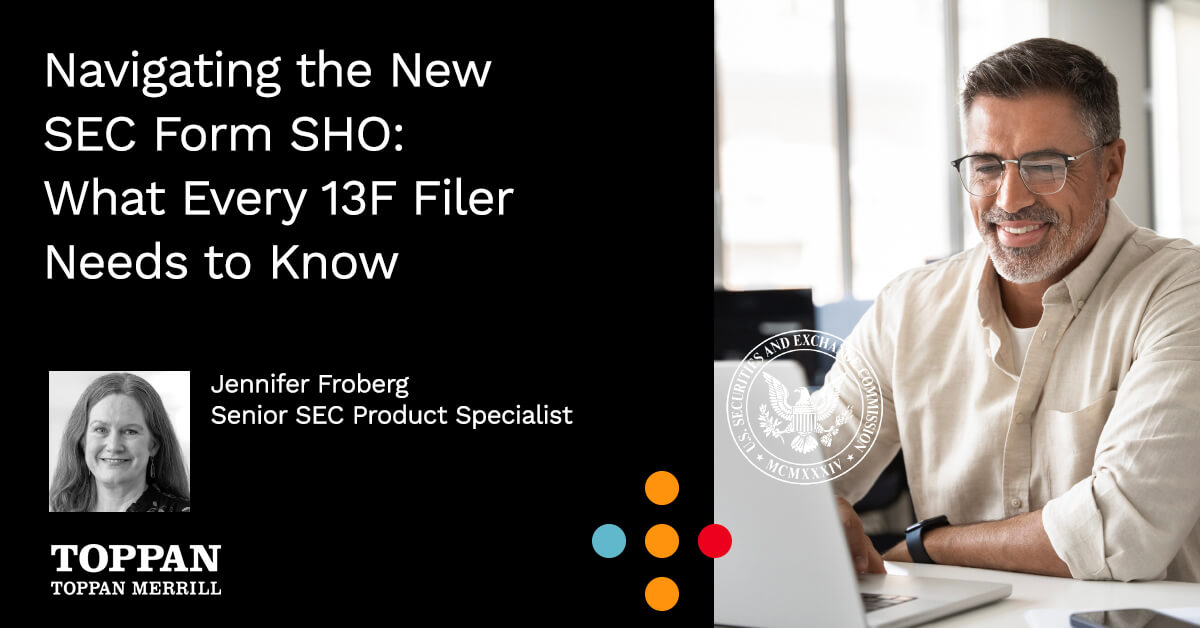Transcript
Scott Snyder: Hello, I’m Scott Snyder, and I’m very pleased to be joined today by Guy Stanzione, Director of Compliance Services, and Gordon Ruckdeschel, Vice President of Compliance Services and Funds from Toppin Merrill’s SEC Compliance Services team, Guy, Gordon, thank you both for joining me.
Guy Stanzione: Thanks, Scott.
Gordon Ruckdeschel: Thanks, Scott. Good to be here.
Scott: Guy, you’ve been writing and blogging about the nine critical challenges funds are going to have to be completely TSR ready in 2024. I’m going to turn it over to you and to Gordon to really continue that discussion about a couple of particular nuances that funds are going to have to be in compliance with related to HTML, XBRL, and ultimately submission to the SEC. But I’d like to start really, Guy, if we could, with the HTML and the iXBRL requirement. There are some particular nuances here, specifically as it relates to Form N-CSR. Can you dive into that a little bit more for our audience.
Guy: Sure, Scott. Thank you. In a significant change to Form N-CSR, the SEC created new Items 7 to 11, which are specific to open end funds. Financial statements, the schedules of investments, and the financial highlights, which were previously in the traditional shareholder report, are now required as item 7a and 7b in the N-CSR. So Gordon, with some of the significant changes that we’re seeing in the N-CSR, as well as the introduction of XBRL that we will talk about in a few moments, give us some insight into what you think filers need to be prepared for with the changes to the N-CSR itself.
Gordon: Sure. Thanks, Guy. A lot of people have been focused on the production of the TSR to date, right? Rightly so, because it’s a huge change from how the reports have been put together up until now. The reality is, this rule didn’t really take much away from what has to be reported, it just kind of shifted everything around, right? So, we end up with these smaller annual and semiannual reports in Item 1, which are the tailored shareholder reports. But then, as you said, all of the financial statements, the holdings, they still have to be part of the filing and that presents a challenge in terms of what do we do with that information now, the way that it’s been prepared by mutual funds in the past, is that going to change and how does it get into the appropriate area of the N-CSR and all married together?
These filings have always been, somewhat challenging, given the fact that the SEC gives funds a lot of leeway and how they pull them together, right? So, you could have 30, 40, 50 funds in one filing, and that could represent several annual or semiannual reports. And as we know now, many, many more tailored shareholder reports than that because they have to be done at the share class level.
So, that balance of how funds are going to pull together the information for the TSR and then also keeping in mind all of that information about the financial statements and the other pieces, disagreements with accountants, et cetera, that make up the 7 to 11 is going to be a challenge for this upcoming year.
Scott: Gordon, can you talk a little bit more about the XBRL sign? I know XBRL is not necessarily new to the fund’s world, but it is new and the SEC put XBRL directly into the TSR at the outset. What do you think’s going on there? Why now and can you read the tea leaves for us as to how the TSR might be used with that XBRL embedded in the document?
Gordon: XBRL, as we know, the SEC has been thinking more and more about structured data with every rule that it brings out. So, it’s no surprise to us, either Guy or myself, that XBRL ended up in this rule. And as you said, funds have been dealing with XBRL on the prospective side of the world for the last 12, 13, 14 years, but this is a first for open end funds in the reports. What it means is essentially almost every piece of information that’s in the Tailored Shareholder Report will have to be not only presented in the filing, but also tagged with some meaning with those XBRL codes, which then allows systems and analysts to compare that information that’s in the Tailored Shareholder Reports systematically from fund to fund.
Scott: Guy, how about from your perspective, what would you add on to Gordon’s comments about sort of the legacy of XBRL really continuing now into the TSR?
Guy: Well, one of the challenges that we see is that the TSR is having to be tagged independently, so each TSR would be XBRL tagged. But at the same time, you would assemble multiple TSRs as part of a filing so if you look at a multi fund annual report that had five or six funds, that would be one book. Now you’re looking at five or six different, plus the share classes, 10, 12, 20 different TSRs that need to be tagged and assembled, which brings up the complexity of XBRL only allows one set of helper files, that you’ll have one schema. So, you can’t just say independently say here you tag this one, you tag this one, you tag this one and put them together without taking into consideration what XBRL means and the elements of XBRL that are required. So, it adds another level of complexity for turnaround time and filing schedules.
Scott: So guys, the HTML, not new, XBRL, not new, been around for a long time at this point with the SEC. But bringing them into the TSR right out of the gate is new for funds. That leads obviously to the question about a platform. How are the funds actually going to do this so selecting a platform that can ultimately support the generation of the xHTML file that’s going to go to the SEC must be critical in the minds of funds at this point knowing that the TSR is coming.
Guy, let me start with you. Platform selection. What are the critical elements here, and why should this be a concern for funds?
Guy: Well, Scott, one of the most commonly used terms is single source of truth, or single source content. So, what you’re looking for in a platform is the ability to transform traditional HTML into SEC compliant xHTML, which is the version of HTML that XBRL must file on. So being able to create that xHTML version without recreating the content is an important way of meeting all the timelines we’ve previously talked about.
Scott: Gordon, from your perspective, platform selection, what would you add onto what Guy mentioned here?
Gordon: From a platform, you really want to make sure as Guy was mentioning that you’ve got, a platform that can pull together the different pieces of that N-CSR filing and successfully give you a filing package to send to the SEC, because along with this structured data, what’s happening is the validation of the filings is getting more complicated making sure that all these different pieces that come together will work together is a challenge. And we, we see this in the fund world more than anywhere else because they tend to be different pieces of the same document coming from different places. And now with this new rule, this becomes even more challenging because of the introduction of the XBRL, the fact that we now have to tag pieces of that Tailored Shareholder Report that may not even be visible to the human eye, right? So, there’s data and plot points underneath some of those charts that need to be tagged. So, the tagging itself is relatively trivial in that we’re not talking about US GAAP here with 20,000 elements to choose from, right? We know what to tag. The challenge is more, how does all of that marry together so that clients have successful filings?
Scott: Gordon, Guy, thanks for joining me today. Obviously, complexities around XBRL, xHTML, Inline XBRL, all in the TSR out of the gate. Lots for funds to consider as the rule becomes effective here in 2024.
Overview
On The Dot (Episode 5) – A conversation with Guy Stanzione and Gordon Ruckdeschel about the SEC Tailored Shareholder Reports mandate and tackling the SEC filing challenges at the share class level.


